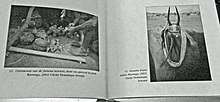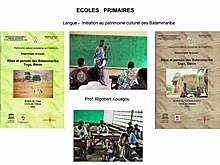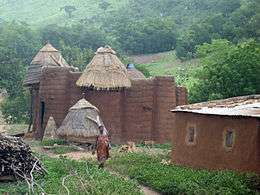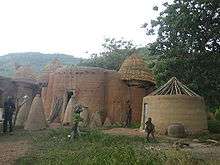Tammari people
The Tammari people, or Batammariba, also known as Otamari, Ottamari, or Somba, are an Oti–Volta-speaking people of the Atakora Department of Benin and neighboring areas of Togo, where they go by the name of Taberma. They are famous for their two-story fortified houses, known as Tata Somba ("Somba house"), in which the ground floor is used for housing livestock at night, internal alcoves are used for cooking, and the upper floor contains a rooftop courtyard and is used for drying grain, sleeping quarters, and granaries. These evolved by adding an enclosing roof to the clusters of huts joined by a connecting wall that are typical of Gur-speaking areas of West Africa. The Tammari are mostly animist by religion. Their language is in the Gur family.


| Tammari | |
|---|---|
| Person | Otammari |
| People | Betammaribe |
| Language | Ditammari |
The Batammariba are agronomic herdsmen who inhabit the hills and valleys. Being clannish by nature, they oppose any form of domination and servitude. Historical research has traced their migration from diverse regions, settling in small groups, while preserving their societal practices of origin. It would be a mistake to presume that the Batammariba tribe form a homogeneous society. The Batammariba language is a strong common link and despite disparities in ceremonial practices, they all affirm allegiance as "Serpent Children". They believe to be the offspring of a grand, invisible, underground "Serpent Mother" who bore the first eggs of their ancestors.
Ethnonym
The name Batammariba (or Batammaliba) means "those who are the real architects of the earth".[1]
Link to the Land
After years (or maybe centuries) of wandering, the Batammariba settled in the valleys. This was a preferable way of existence to their former history of conflict over law imposing warlords and chieftains. Their name implies a close connection to the land where rituals are practised. The underground region is the domain of dead spirits to whom the Batammariba owe their very existence with nature and the ability to generate. The Batammariba do not consider themselves to be landowners but as caretakers. Their settlement could not have happened without the intercession of The Babietiba, first settlers, who belonged to a highly culturally evolved group of foragers, then introduced them to the “true owners of the region”: underground forces incarnates into a source such as a rock or a tree. Ancestors of Batammaribas concluded an alliance with these forces, swearing they would respect some agricultural rules and respect the pieces of land that belonged to these forces. In exchange of what, the ancestors where allowed to build houses, to harvest the soil. Initiations or rituals are meetings with underground forces. This link to the underground forces demanded bravery, self-mastery, and discretion, essential qualities by which the Batammaribas are formed from a young age.
The Takyenta
The Takyenta, traditional dwelling, is typically constituted from mud and surrounded by towers that support garrets, evoking a medieval citadel. The dwellings each have a masculine south orientation and a feminine north orientation. Models of takyentas differ from village to village. The storied construction with its solid walls acts as a protective fortress to keep out invaders and repel fatal spear attacks on its inhabitants. It also served as protection against leopards who, according to the village elders roamed freely in the overgrown bush. Building the fortress took several months and required much skilled labor. The upper floor was a living space and a safety haven. Up until 2000 parents and their children slept in elevated box structures placed on the sides and center areas of the terrasse. These boxes were also designed to protect the inhabitants and their guests from the midday heat. Nowadays the fortresses are reserved for ancestral devotional ceremonies. The souls of the ancestors reside in the earthen cone-shaped altars. Strangers cannot enter the temple area without permission from the head of the home. On the exterior south side of the fortress are the altars containing animal spirits of animals that were formerly hunted and killed. The altar can also contain underground spirits by which those ancestors who possessed the gift of "sight" had made a pact. Therefore, the connection between the dwellings and the sacred altars of the village is extremely strong.
Traditional Religion
The traditional religion of the Batammariba centers around one Supreme Deity, Kuiye, the sun god and creator of both gods and humans. Kuiye is believed to resemble a human in appearance, but is also considered to be both male and female, so that the deity is often referred to as "The Sun, Our Father and Our Mother".[2] Like all living beings, according to Batammariba thought, Kuiye possesses a corporeal form known as Kuiye, and a soul, known as Liye. Kuiye, the corporeal form of the deity, is thought to live in the "sun village" in the west, above the sky, while Liye travels the sky each day in the form of a disc of light.[3]
Butan, the goddess of the Earth and the Underworld, is Kuiye's complement as either Kuiye's wife or twin.[4] Butan is the ruler of everything within the Earth or on its surface, including vegetal growth and agriculture, game proliferation, cemeteries, etc. Her corporeal form, invisible to humans, is said to resemble a mudfish, an animal that is thought to vomit up an infinite amount of water. Because of this, her main shrine is a village spring. Her complementary soul is called Bupe, and is visible as the surface of the Earth.[5]
The third major Batammariba deity is Oyinkakwata, "the Rich Man Above", who is the god of the sky, of thunder, lightning and storms. His soul is visible to humans in the form of lightning, but his invisible body is said to be filled with air.[6]
But the Batammariba world is filled with many more deities who are quite different than the three cosmological gods described above. These deities are initiation deities who select their worshipers according to various factors such as gender, martial prowess, ability for clairvoyance, etc. They include the Fawafa, the Python deity of men's initiations, Fakuntifa, the lizard deity of women's initiations, Fayenfe, the god of war and death, Litakon, the god of twins and fertility, Kupon, the deity of divination, etc.[7]
These deities are better considered families of deities, or deity types, rather than unique deities: there are male and female Fawafa deities, for example, who are believed to produce offspring of their deity type. The Batammariba may acquire these deities by inheriting them from someone, hunting and capturing them in the wild, or by buying and selling them to and from their neighbors. The matriarch, and presumably most powerful, of each deity type is believed to reside in Linaba, the mythological first village where Kuiye first created humans and deities.[7]
Foundation of Batammaribas
This connection is a cosmic expression of Batammariba spirituality and they have shown themselves to be intractable concerning their foundation. They maintain a strictly age based hierarchy between the elders and the younger ones (as in all African societies) but oppose any form of centralized power, rejecting hereditary chieftains. Two, four or six clans can form a "village" or, to be more precise, a "territorial groupement" centered around the rituals upheld by each clan. A ritual center is the foundation of the village and is organized around a cemetery, a large initiation house for the youth, and the head serpent sanctuary. The clans share and recognize a certain family bondage as they all descend from the same founding fathers. Another important pillar of the Batammariba is an exceptionally preserved system of funeral rites and initiation ceremonies. Those responsible for the rituals are imbued with authority and are chosen following rigorous ethics notably discretion and self-mastery as, for example, if one is threatened with a knife, prefers to be killed than to kill. Nowadays the Batammariba accord the same importance to their rituals. The youngest amongst them, whether schooled or not, leaves or stays in the village, will very rarely not keep the cycle of initiation tradition. Fidelity to tradition, like caring and respecting the land on which their survival depends, their natural pride, warrior traditions, and hunting skills are being intensely revived with ceremony. This has permitted the Batammariba to resist outside influences that negate their determination to maintain a millenary heritage that makes their culture so remarkable.(source : "Le Souffle du Mort - La tragédie de la mort chez les Batammariba (Togo, Bénin)", Dominique Sewane, collection Terre Humaine, ed. Plon, Paris, 2020.
From 19 to 24 October October 2018, UNESCO organized an emergency mission to assess the damage allegedly caused by the August 2018 rains in Koutammakou on habitat and on the intangible heritage. The report was prepared by three international experts: Ishanlosen Odiaua, Dominique Sewane and Franck Ogou. https://whc.unesco.org/fr/documents/171736 [archive]
Those who have studied this people
- Leo Frobenius
German anthropologist and archaeologist (1873-1938). The archives of the Institute Frobenius associated with the Johann Wolfgang Goethe University of Frankfurt am Main (including four scientific collections and important image bank), are regularly consulted.
- Paul Mercier
Anyone interested in populations of Atakora, can refer to different works of Paul Mercier. His investigations in the region in 1950 Natitingou concern the movements of the different subgroups tammariba and their neighbors. His numerous articles accurately describe their social organization and land tenure. Prodigious research, still unmatched, if we consider that they were carried out alone, and for the first time, in a relatively short time.
- Albert Marie Maurice
Military Natitingou in 1950, Albert Marie Maurice (1913-200211) has conducted extensive research on this company. His photographic archives of great value, are in the Academy of Sciences of oversea.
- Rigobert Kouagou
Originally from Natitingou (Benin), Rigobert Kouagou was always passionate about its origins and language, Ditammari, whose he is one of the specialists. He is the author of poems and stories translated into French.
- Dominique Sewane
French ethnologist Dominique Sewane: since the 1980s, researches focused mainly on funeral and initiation rites of Batammaribas of Togo, which resulted in numerous publications and reference works.
Notes
- Blier 1987, p. 2.
- Blier 1987, p. 83
- Blier 1987, p. 84
- Blier 1987, p. 90
- Blier 1987, p. 91
- Blier 1987, p. 97
- Blier 1987, p. 100
References
- Blier, Suzanne (1987). The Anatomy of Architecture: Ontology and Metaphor in Batammaliba Architectural Expression. Chicago, USA: University of Chicago Press. ISBN 0226058611.CS1 maint: ref=harv (link)
Bibliography
Céline Al Zoubi, « L’Agriculture tammari dans l’Atakora. Anthropo histoire des techniques agricoles des Batammariba de l’Atakora pré-colonial (Togo, Bénin). Pistes de recherche », mémoire de master I et II d’histoire des techniques, Université de Paris-I, 2008.
Suzanne Preston Blier, The Anatomy of Architecture. Ontology and Metaphor in Batammaliba Architectural expression, Cambridge University Press, 1987. Charles Bonnet, Des pharaons venus d’Afrique, la cachette de Kerma (en collaboration avec D. Valbelle), Paris, Citadelles et Mazenod, 2005.
Gaël Kpotogbé Amoussou, L’Imaginaire des Batammariba du Togo à travers leur habitat, Le Nègre Éditeur, 2011.
Gaël Kpotogbé Amoussou, Transmission du savoir-faire, PAF, 2014.
Philippe Charlier, Zombis, enquête anthropologique sur les morts vivants, Tallandier, 2015.
Robert Cornevin, Histoire du Togo, Paris, Berger-Levrault, 1959, 427 p.
Robert Cornevin, Histoire des peuples d’Afrique Noire, Paris, Berger Levrault, 1962, 716 p.
Lazare Eloundou, avec Odiaua Ishanlosen, Patrimoine Mondial africain. Une diversité remarquable (préface Irina Bokova), éditions 696 Unesco, 2013.
Leo Frobenius, 1912‑1913, Und Africa sprach. Bericht über den Verlauf der 3. Reiseperiode des DIAFE in den Jahren 1910‑1912, Vita, Berlin-Charlotenburg, t. III, Unter den unsträfftlichen Aethiopen, 1913, 669 p.
- Nicoué-Lodjou Gayibor, Histoire des Togolais des origines aux années 1960, Karthala, 2011
Alain Godonou, « École du patrimoine africain », Africultures, 2007/1 (n° 70)
Tilo Grätz, « La rébellion de Kaba (1916‑1917) dans l’imaginaire politique au Bénin », Paris, Cahiers d’études africaines, 160, 2000
- Marie et Philippe Huet, Koutammarikou - Somba Portraits - Nord Bénin, éditions Hesse, 2012, 155 p. (ISBN 978-2357060210)
Joseph Ki-Zerbo, Histoire de l’Afrique noire d’hier à demain, Hatier, 1972, 682 p.
- Rigobert Kpanipa Kouagou, 'L'identité Tammari', Université nationale du Bénin, Cotonou, 1984 (Master's Thesis)
- Rigobert Kpanipa Kouagou, Le défi identitaire du peuple Tammari, FACTAM, Natitingou, République du Bénin, 2002.
- Koumba N. Koussey, Le peuple otammari, Essai de synthèse historique, Université nationale du Bénin, Cotonou, 1977 (Master's Thesis)
- Bakoukalébé Kpakou, « Histoire du peuple tammari de Koutougou du xviiie siècle à l’époque coloniale », mémoire de maîtrise, Université de Kara, Togo, 2014.
N’Tcha Layota, « Analyse parémiologique ditamari. Structure syn‑taxique et ethno-sémantique de la parémie », thèse de doctorat, Université d’Abomey-Calavi, Cotonou, Bénin, 2019
- Albert-Marie Maurice, Atakora, Otiau, Otammari, Osari, Peuples du Nord-Bénin (1950), Académie des sciences d’outre-mer, Paris, 1986, 481 p.
- Achille Mbembe, Afriques indociles, Karthala, 1988.
- Elikia M'Bokolo, L’Afrique au xxe siècle. Le continent convoité, Seuil, 1985.
- Paul Mercier, Tradition, changement, histoire. Les « Somba » du Dahomey septentrional, ed. Anthropos, Paris, 1968, 538 p. (compte-rendu par Jean-Pierre Chrétien, Annales. Économies, Sociétés, Civilisations, année 1969, vol. 24, no 3, p. 640-648, en ligne sur Persée [11])
Paul Mercier, « Marques du statut individuel chez les Somba », Conferencia international des africanistas ocidentais. 2a confe‑rencia (Bissau 1947), Lisbonne, t. V, 1952, pp. 219‑240.
Paul Mercier, « L’habitat et l’occupation de la terre chez les “Somba” », Bulletin de l’IFAN, t. XV, no 2, 1953, pp. 798‑817.
Paul Mercier, « L’habitation à étage dans l’Atakora », Études daho‑méennes, t. XI, 1954, pp. 29‑79. Paul Mercier, Civilisation du Bénin, Paris, Société continentale d’éditions modernes illustrées, 1962, 365 p Paul Mercier), Histoire de l’Anthropologie, Paris, PUF, 1966. Paul Mercier, Tradition, changement, histoire. Les « Somba » du Dahomey septentrional, Paris, Anthropos, 1968, 538 p.
Bantchin Napakou, L’Universalité des droits de l’homme dans la modernité politique. De l’éthique de la diversité à la trans‑culturalité en Afrique, éditions universitaires européennes, 2016. Théophile Nata, Étude descriptive du ditãmmari, Rapport de fin de 1re année de doctorat de 3e cycle de linguistique, 1974.
Didier N’Dah, « Sites archéologiques et peuplement de la région de l’Atakora (nord-ouest du Bénin) », thèse de doctorat en archéologie africaine, vol. 1 et 2, Université de Ouagadougou, 2008‑2009. N'Dah N’Dati, « Le Kutammaaku (Togo-Bénin) du xviie siècle à la conquête coloniale », thèse de doctorat, Université de Lomé, 2017
Komi N’Kéré, Cartes du Koutammakou. Aires sacrées. Limites, itinéraires, intr. D. Sewane, Patrimoine culturel immatériel de l’Unesco, Japan Fund, 2009.
K.J. N’Tcha, « L’anthropologie économique des Betammaribe dans l’Atakora », mémoire de maîtrise, Université du Bénin, 1983.
Sylvain Prudhomme, dir., Contes du pays tammari (Bénin), 2003, Paris, Karthala, 196 p.
Dominique Sewane (sous le nom de Myriam Smadja) « La maison qui s'enfonce sous la terre (Tamberma du Togo) », in Pour Jean Malaurie : 102 témoignages en hommage à quarante ans d’études arctiques (dir. Sylvie Devers), éditions Plon, Paris, 1990, p. 79-89 (ISBN 9782259019132)
Dominique Sewane(sous le nom de Myriam Smadja)«Les affaires du mort (Tamberma du Nord-Togo) » [archive], in Systèmes de pensée en Afrique noire, no 11, 1991, p. 57-90.
Dominique Sewane, La Lance et le Serpent. Rituels du dikuntri et du difwani des Tammariba du Togo, École pratique des hautes études, Paris, 1999, 2 vol., 446 p. (thèse d'Ethnologie)
Dominique Sewane, « Celles qui tombent chez les Tammariba du Togo », in Familiarité avec les dieux. Transe et possession (Afrique noire, Madagascar, la Réunion) (dir. Marie-Claude Dupré), Presses Universitaires Blaise-Pascal, Clermont-Ferrand, 2001, p. 185-221 (ISBN 978-2-84516-147-4)
Dominique Sewane, « Le premier sorgho et la confrérie des Vrais Hommes chez les Tamberma du Togo », in Cuisine et société en Afrique – Histoire, saveurs, savoir-faire (dir. Monique Chastenet, François-Xavier Fauvelle-Aymar et Dominique Juhe-Beaulaton), Karthala, Paris, 2002, p. 85-102 (ISBN 9782845862784)
Dominique Sewane, La Nuit des Grands Morts. L’initiée et l’épouse chez les Tamberma du Togo (préface de Jean Malaurie), Economica, Paris, 2002, « coll. Afrique Cultures », 272 p. (ISBN 9782717844849) (note de lecture par Suzanne Lallemand dans le Journal des africanistes, 74-1/2, 2004, p. 527-529 [12] [archive])
Dominique Sewane, Rapport final en vue de l’inscription du Koutammakou, pays des Batammariba au Togo, sur la liste des sites classés du Patrimoine mondial de l’Unesco, décembre 2002, 102 p. Document utilisé pour la rédaction de l’article
Dominique Sewane, Les Batãmmariba, le peuple voyant : carnets d'une ethnologue, Éd. de La Martinière, Paris, 2004, 189 p. (ISBN 2-7324-3209-1)
Dominique Sewane, « Puissance du nom. Les noms secrets des Batãmmariba du Togo, Bénin », in La mort et l’immortalité : encyclopédie des savoirs et des croyances (dir. Jean-Philippe de Tonnac et Frédéric Lenoir), Bayard, Paris, 2004, p. 855-866 (ISBN 9782227471344)
Dominique Sewane, "La tombe et ses orientations », in Antigone et le devoir de sépulture : actes du colloque international de l'Université de Lausanne (mai 2005) (dir. Muriel Gilbert), Labor Fides, Lausanne, novembre 2005, p. 161-176 (ISBN 2-8309-1173-3)
Dominique Sewane, Le souffle du mort : la tragédie de la mort chez les Batãmmariba du Togo, Bénin, Plon, Paris,2003, collection Terre Humaine, Plon, 2007, 849 p., 2020, collection Terre Humaine, Plon (ISBN 978-2-266-17579-1) (cf notes de lecture [13] [archive] et [14] [archive]) Document utilisé pour la rédaction de l’article
Dominique Sewane, Rapport de coordination du Programme de sauvegarde du Patrimoine culturel immatériel des Batammariba du Koutammakou – Première Phase (novembre 2008-novembre 2009)
Dominique Sewane, « Le Koutammarkou, haut lieu de l’humanité », in Dieux, rois et peuples du Bénin : arts anciens du littoral aux savanes (dir. Hélène Joubert et Christophe Vital), Musée Branly, Somogy, 2008, p. 106-111 (ISBN 978-2757201855)
Dominique Sewane, Rites et pensée des Batammariba pour les écoles primaires du Togo - Ministère des enseignements primaire secondaire et de l’alphabétisation du Togo, Patrimoine Culturel Immatériel de l’UNESCO, éditions Haho, Lomé (Togo), 2009 (in Programme de sauvegarde du Patrimoine immatériel des Batammariba – Unesco-Japan)
Dominique Sewane, « Le voyant, le devin et le maître du savoir chez les Batammariba (Togo, Bénin) », in Soazick Kerneis et Raymond Verdier, Les Justices de l'invisible, L'Harmattan, Paris, 2013, p. 145-180 (ISBN 9782336328041) (actes du colloque de Paris)
Dominique Sewane, « Carnets de terrain au Koutammakou (Togo) », in Revue de la BNF, 2013/3, no 45, p. 40-48
Dominique Sewane, " Transmission des savoirs au Koutammakou", in Regards scientifiques sur l'Afrique depuis les indépendances (dir. M. Lafay, F. Le Guennec-Coppens, E. Coulibaly), Karthala, Paris, 2016, 486 p.,pp. 179–209
Dominique Sewane avec Bantéé N’Koué et Bakoukalébé Kpakou Koutammakou - Lieux sacrés, Préface de Jean Malaurie, Postface de Marcus Boni Teiga, éditions Hesse, 2018, ISBN 978-2-35706-041-8
Marcus Boni Teiga, Patrimoine. Le legs de l’Afrique noire à la Grèce et la Rome antique, Complicités, 2019.
Ibrahima Thioub,(éd). Patrimoines et sources historiques en Afrique, Dakar, Union académique internationale, UCAD, 2007, 179 p.
Jean-Pierre Vallat (dir.), Le Togo. Lieux de mémoire et sites de conscience, L’Harmattan, 2013.
Gallery
 The entrance of a Tammari house, with twin altars
The entrance of a Tammari house, with twin altars A Tammari house with granaries. The forked poles at the left granary are ladders, with steps cut along their lengths
A Tammari house with granaries. The forked poles at the left granary are ladders, with steps cut along their lengths Neighboring Tammari houses, with multiple altars
Neighboring Tammari houses, with multiple altars
External links
- https://www.canal-u.tv/video/fmsh/l_aventure_terre_humaine.30929
- http://www.quaibranly.fr/fr/expositions-evenements/au-musee/rendez-vous-du-salon-de-lecture-jacques-kerchache/details-de-levenement/e/le-koutammakou-et-ses-liens-avec-les-forces-de-la-* terre-38543/
- HTTPS://ICH.UNESCO.ORG/FR/KIT
- https://whc.unesco.org/fr/documents/171736